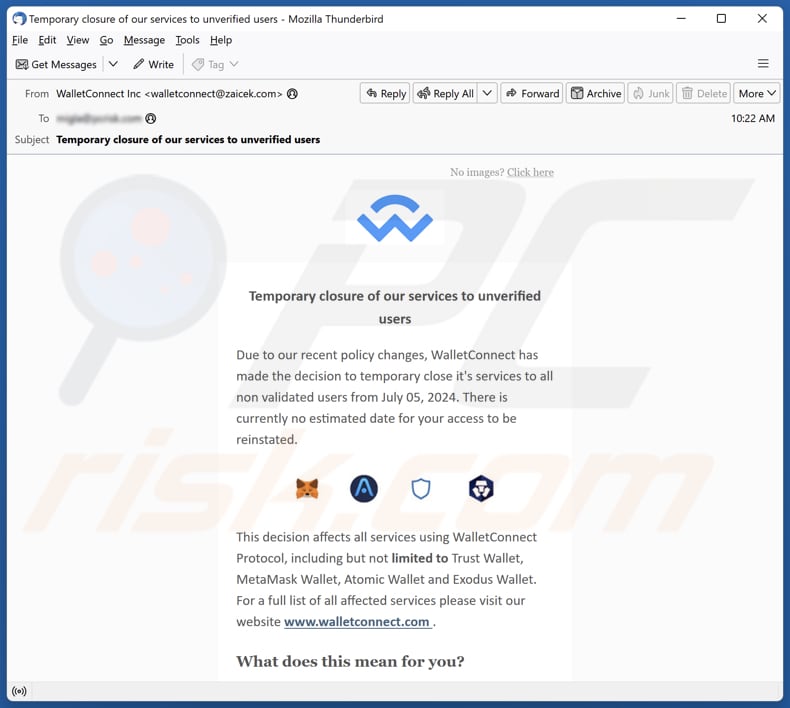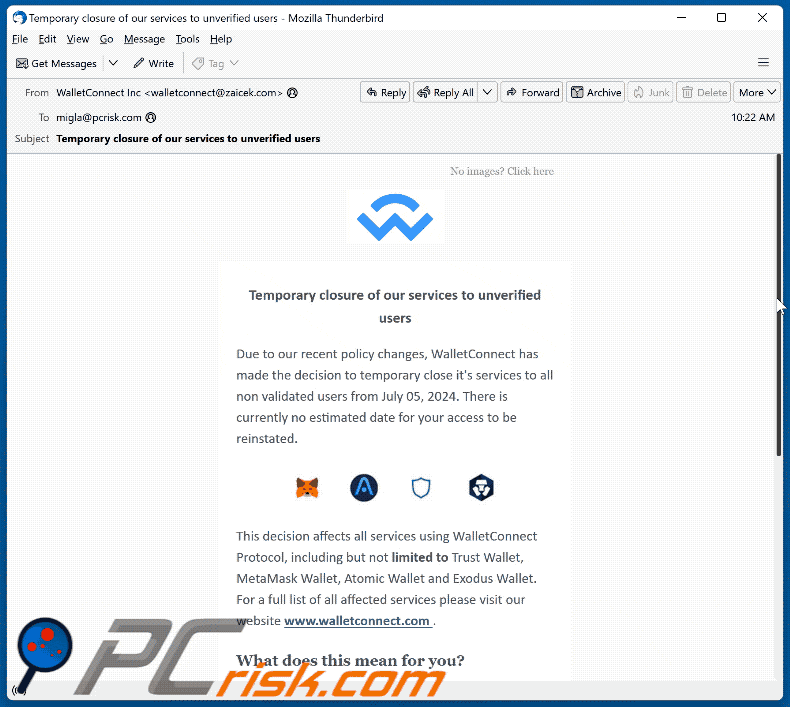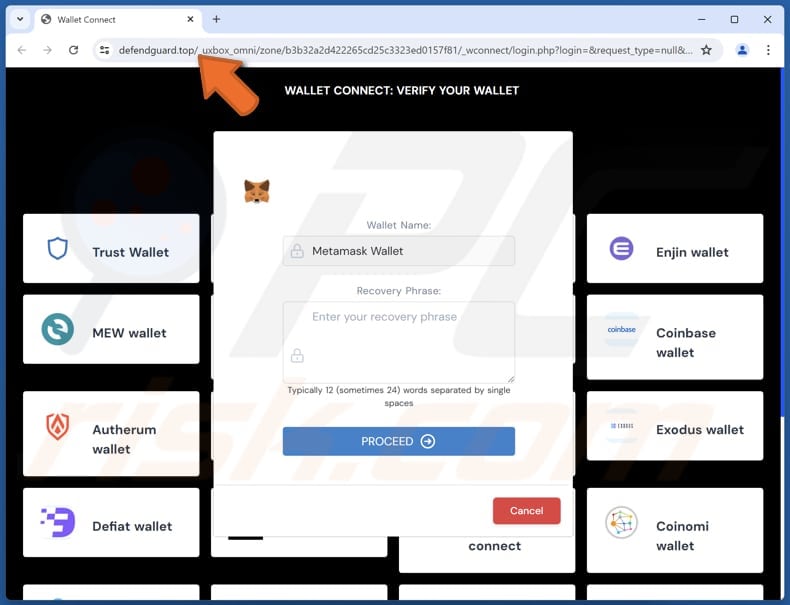How to identify scams like "WalletConnect Temporary Closure"
Phishing/ScamAlso Known As: WalletConnect Temporary Closure phishing email
Get free scan and check if your device is infected.
Remove it nowTo use full-featured product, you have to purchase a license for Combo Cleaner. Seven days free trial available. Combo Cleaner is owned and operated by RCS LT, the parent company of PCRisk.com.
What is "WalletConnect Temporary Closure"?
We have reviewed the email and found that it is written by scammers who pretend to be representatives of WalletConnect, a legitimate IT service management company. This scam email is utilized to trick recipients into disclosing personal information via a fake web page. Recipients should ignore this email.

More about the "WalletConnect Temporary Closure" scam email
This email is a phishing letter masquerading as a notification from WalletConnect. It claims that WalletConnect will temporarily close services to unverified users starting July 5, 2024 (the date might vary), and urges recipients to validate their wallets to prevent closure.
It also mentions popular wallets like Trust Wallet and MetaMask and states that funds will not be accessible until validation. The email includes a link/button ("Validate Wallet") to validate the wallet, which leads to a phishing website.
This phishing website instructs visitors to verify their wallets by choosing a wallet name from the list and entering their recovery phrases. All entered information is sent to scammers, who can misuse it to access cryptocurrency wallets and drain them. They may also sell the obtained information to third parties on the dark web.
Such actions not only result in financial loss for the victims but can also lead to further identity theft and fraud. Thus, users should always ensure they are interacting with official and secure platforms to protect their sensitive information and never respond to scammers.
| Name | WalletConnect Temporary Closure Email Scam |
| Threat Type | Phishing, Scam, Social Engineering, Fraud |
| Fake Claim | WalletConnect users must verify their wallets |
| Disguise | Letter from WalletConnect |
| Related Domain | defendguard[.]top |
| Detection Names (defendguard[.]top) | alphaMountain.ai (Phishing), CyRadar (Phishing), Fortinet (Phishing), Trustwave (Suspicious), URLQuery (Suspicious), Full List Of Detections (VirusTotal) |
| Symptoms | Unauthorized online purchases, changed online account passwords, identity theft, illegal access of the computer. |
| Distribution methods | Deceptive emails, rogue online pop-up ads, search engine poisoning techniques, misspelled domains. |
| Damage | Loss of sensitive private information, monetary loss, identity theft. |
| Malware Removal (Windows) |
To eliminate possible malware infections, scan your computer with legitimate antivirus software. Our security researchers recommend using Combo Cleaner. Download Combo CleanerTo use full-featured product, you have to purchase a license for Combo Cleaner. 7 days free trial available. Combo Cleaner is owned and operated by RCS LT, the parent company of PCRisk.com. |
Conclusion
In conclusion, phishing emails are fraudulent messages crafter to lure recipients into disclosing sensitive information via email or deceptive/fake web pages. Usually, scammers aim to extract login credentials, credit card details, social security numbers, ID card information, or other details.
Their emails are often disguised as urgent letters from reputable companies or other entities. It is important to mention that fraudulent email can be used to trick recipients into launching malware on their computers.
Here are some examples of phishing emails: "Your Email Account Needs To Be Re-verified", "Restore/Confirm Your Email Access", and "Review For Your Account".
How do spam campaigns infect computers?
When fraudulent emails are crafted to deliver malware, they contain malicious attachments (files) or links. Users can infect computers by opening malicious files or websites designed to automatically download malware on their computers. Also, computers can be infected via malicious files downloaded by users from the websites included in emails.
Not all files infect computers upon opening. For instance, malicious MS Office documents inject malware after macros commands are enabled. Archive files, if not extracted and their contents are not executed, cannot deploy malware as well. However, opening malicious executables usually infects computers immediately.
How to avoid installation of malware?
Download software and files exclusively from trusted sources such as official websites or app stores. Exercise caution with unexpected emails, especially from unfamiliar senders; refrain from clicking on links or opening attachments included in such emails. Refrain from downloading pirated software, cracking tools, or unofficial key generators, as they often harbor malware.
Do not click ads, buttons, or pop-ups on shady web pages, and do not agree to receive notifications from such sites. Ensure your operating system and installed software are regularly updated. Finally, regularly scan your computer for threats. If you have already opened malicious attachments, we recommend running a scan with Combo Cleaner Antivirus for Windows to automatically eliminate infiltrated malware.
The appearance of the "WalletConnect Temporary Closure" scam email (GIF):

Text presented in the "WalletConnect Temporary Closure" email letter:
Subject: Temporary closure of our services to unverified users
Temporary closure of our services to unverified users
Due to our recent policy changes, WalletConnect has made the decision to temporary close it's services to all non validated users from July 05, 2024. There is currently no estimated date for your access to be reinstated.
This decision affects all services using WalletConnect Protocol, including but not limited to Trust Wallet, MetaMask Wallet, Atomic Wallet and Exodus Wallet. For a full list of all affected services please visit our website www.walletconnect.com .
What does this mean for you?During this period your funds would not be accessible until these restrictions are lifted. Receiving transactions will still be possible. To prevent closure use the button below to validate your wallet
Validate Wallet
© 2024 WalletConnect Inc
Preferences | Unsubscribe
Screenshot of the phishing email used in this scam:

Instant automatic malware removal:
Manual threat removal might be a lengthy and complicated process that requires advanced IT skills. Combo Cleaner is a professional automatic malware removal tool that is recommended to get rid of malware. Download it by clicking the button below:
DOWNLOAD Combo CleanerBy downloading any software listed on this website you agree to our Privacy Policy and Terms of Use. To use full-featured product, you have to purchase a license for Combo Cleaner. 7 days free trial available. Combo Cleaner is owned and operated by RCS LT, the parent company of PCRisk.com.
Quick menu:
- What is WalletConnect Temporary Closure phishing email?
- Types of malicious emails.
- How to spot a malicious email?
- What to do if you fell for an email scam?
Types of malicious emails:
![]() Phishing Emails
Phishing Emails
Most commonly, cybercriminals use deceptive emails to trick Internet users into giving away their sensitive private information, for example, login information for various online services, email accounts, or online banking information.
Such attacks are called phishing. In a phishing attack, cybercriminals usually send an email message with some popular service logo (for example, Microsoft, DHL, Amazon, Netflix), create urgency (wrong shipping address, expired password, etc.), and place a link which they hope their potential victims will click on.
After clicking the link presented in such email message, victims are redirected to a fake website that looks identical or extremely similar to the original one. Victims are then asked to enter their password, credit card details, or some other information that gets stolen by cybercriminals.
![]() Emails with Malicious Attachments
Emails with Malicious Attachments
Another popular attack vector is email spam with malicious attachments that infect users' computers with malware. Malicious attachments usually carry trojans that are capable of stealing passwords, banking information, and other sensitive information.
In such attacks, cybercriminals' main goal is to trick their potential victims into opening an infected email attachment. To achieve this goal, email messages usually talk about recently received invoices, faxes, or voice messages.
If a potential victim falls for the lure and opens the attachment, their computers get infected, and cybercriminals can collect a lot of sensitive information.
While it's a more complicated method to steal personal information (spam filters and antivirus programs usually detect such attempts), if successful, cybercriminals can get a much wider array of data and can collect information for a long period of time.
![]() Sextortion Emails
Sextortion Emails
This is a type of phishing. In this case, users receive an email claiming that a cybercriminal could access the webcam of the potential victim and has a video recording of one's masturbation.
To get rid of the video, victims are asked to pay a ransom (usually using Bitcoin or another cryptocurrency). Nevertheless, all of these claims are false - users who receive such emails should ignore and delete them.
How to spot a malicious email?
While cyber criminals try to make their lure emails look trustworthy, here are some things that you should look for when trying to spot a phishing email:
- Check the sender's ("from") email address: Hover your mouse over the "from" address and check if it's legitimate. For example, if you received an email from Microsoft, be sure to check if the email address is @microsoft.com and not something suspicious like @m1crosoft.com, @microsfot.com, @account-security-noreply.com, etc.
- Check for generic greetings: If the greeting in the email is "Dear user", "Dear @youremail.com", "Dear valued customer", this should raise suspiciousness. Most commonly, companies call you by your name. Lack of this information could signal a phishing attempt.
- Check the links in the email: Hover your mouse over the link presented in the email, if the link that appears seems suspicious, don't click it. For example, if you received an email from Microsoft and the link in the email shows that it will go to firebasestorage.googleapis.com/v0... you shouldn't trust it. It's best not to click any links in the emails but to visit the company website that sent you the email in the first place.
- Don't blindly trust email attachments: Most commonly, legitimate companies will ask you to log in to their website and to view any documents there; if you received an email with an attachment, it's a good idea to scan it with an antivirus application. Infected email attachments are a common attack vector used by cybercriminals.
To minimise the risk of opening phishing and malicious emails we recommend using Combo Cleaner Antivirus for Windows.
Example of a spam email:

What to do if you fell for an email scam?
- If you clicked on a link in a phishing email and entered your password - be sure to change your password as soon as possible. Usually, cybercriminals collect stolen credentials and then sell them to other groups that use them for malicious purposes. If you change your password in a timely manner, there's a chance that criminals won't have enough time to do any damage.
- If you entered your credit card information - contact your bank as soon as possible and explain the situation. There's a good chance that you will need to cancel your compromised credit card and get a new one.
- If you see any signs of identity theft - you should immediately contact the Federal Trade Commission. This institution will collect information about your situation and create a personal recovery plan.
- If you opened a malicious attachment - your computer is probably infected, you should scan it with a reputable antivirus application. For this purpose, we recommend using Combo Cleaner Antivirus for Windows.
- Help other Internet users - report phishing emails to Anti-Phishing Working Group, FBI’s Internet Crime Complaint Center, National Fraud Information Center and U.S. Department of Justice.
Frequently Asked Questions (FAQ)
Why did I receive this email?
Phishing attacks are often sent to a large number of email addresses randomly. Your email address may have been included in a list obtained from a data breach or purchased on the dark web.
I have provided my personal information when tricked by this email, what should I do?
If you have provided your crypto wallet's seed phrase, change it as soon as possible. If you cannot access your wallet, contact the service provider.
I have downloaded and opened a malicious file attached to an email, is my computer infected?
It depends on the file type you have opened. If that file is executable, then your computer is probably infected. In other cases (e.g., if you have opened an MS Office or PDF document), you may have avoided malware infiltration.
I have read the email but did not open the attachment, is my computer infected?
No, emails cannot infect computers (but their contents can, if malicious and opened).
Will Combo Cleaner remove malware infections that were present in email attachment?
Yes, Combo Cleaner can detect and remove nearly all known malware infections. However, advanced malware often hides deeply within the system, so performing a complete system scan is essential for thorough removal.
Share:

Tomas Meskauskas
Expert security researcher, professional malware analyst
I am passionate about computer security and technology. I have an experience of over 10 years working in various companies related to computer technical issue solving and Internet security. I have been working as an author and editor for pcrisk.com since 2010. Follow me on Twitter and LinkedIn to stay informed about the latest online security threats.
PCrisk security portal is brought by a company RCS LT.
Joined forces of security researchers help educate computer users about the latest online security threats. More information about the company RCS LT.
Our malware removal guides are free. However, if you want to support us you can send us a donation.
DonatePCrisk security portal is brought by a company RCS LT.
Joined forces of security researchers help educate computer users about the latest online security threats. More information about the company RCS LT.
Our malware removal guides are free. However, if you want to support us you can send us a donation.
Donate
▼ Show Discussion